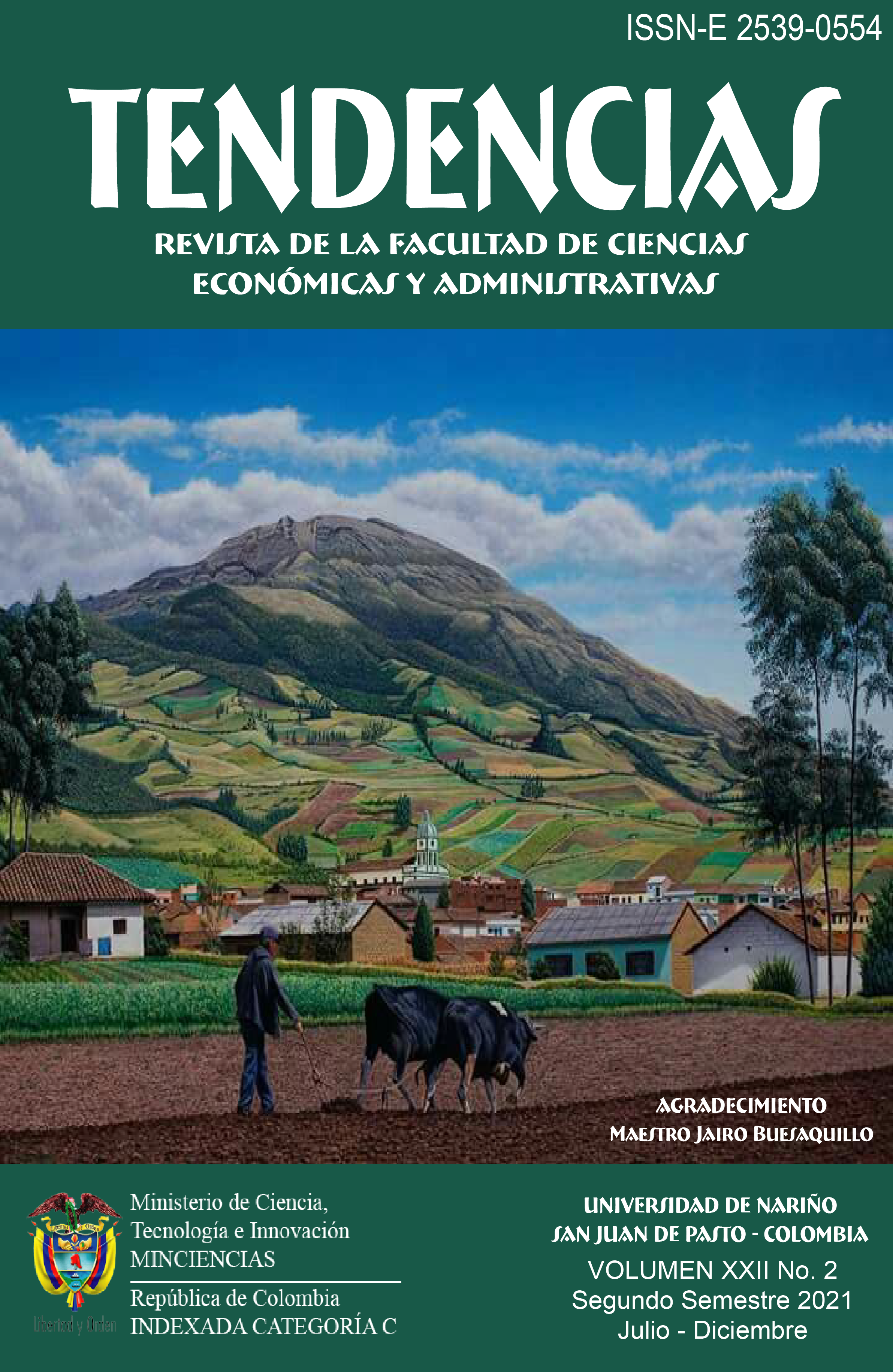Application of the nerlovian partial adjustment model to estimate plantain supply elasticity in Colombia
DOI:
https://doi.org/10.22267/rtend.212202.168Keywords:
cointegration, stationarity, price expectations, supply response, vector autoregressiveAbstract
The objective of this study was to estimate the response of the plantain supply and the short and long-term elasticities through the partial adjustment model developed by Nerlove, based on the period between 2000 and 2018. An explanatory, quantitative and correlational research design was applied and for the empirical estimation, the methodology of autoregressive vectors was used. The results indicated that the coefficients associated with lagged price and production were positive, significant and consistent with economic theory. The short-term elasticities were inelastic and similar to studies related to permanent crops, thus price polices are not an effective tool to increase supply due the low response to price movements.
Downloads
References
(1) Akaike, H. (1974). A new look at the statistical model identification. IEEE Transactions on Automatic Control, 19(6), 716-723. https://doi.org/10.1109/TAC.1974.1100705
(2) Álvarez, L., León, A., Sánchez, M., & Cusme, B. (2020). Evaluación socioeconómica de la producción de plátano en la zona norte de la Provincia de los Ríos. Journal of Business and Entrepreneurial, 4(2), 86-97. https://doi.org/10.37956/jbes.v4i2.78
(3) Askari, H., & Cummings, J. (1977). Estimating agricultural supply response with the Nerlove model: A survey. Economic Review, 18(2), 257-292. https://doi.org/10.2307/2525749
(4) Briceño, F., Rojas, A., & Coydán, I. (2005). Politicas de precios en Chile: El caso de los cereales. Panorama Socioeconómico, 23(31), 58-70.
(5) Chique, V., Rosales R. & Samacá H. (2006). Efectos de la liberalización comercial: un análisis de equilibrio parcial para el sector de arroz en Colombia. Documento CEDE 2006-37.
(6) Dlamini, D. (2018). Supply response of potato to price and non-price factors in Swaziland. Archives of Business Research, 6(10), 78-85. https://doi.org/10.14738/abr.610.5248
(7) Espinal, C., Martínez, J., & Peña, M. (2005). La cadena de plátano en Colombia: Una mirada global de su estrucutra y dinámica 1991-2005. Bogotá: Observatorio Agrocadenas, Documento de trabajo No 61.
(8) Espinosa, A., & Vaca, P. (2011). Impactos y consecuencias en el sector azucarero en Colombia a partir del TLC con la Unión Europea. Horizontes Empresariales, 11(2), 7-34.
(9) Organización de las Naciones Unidas para la Alimentación y la Agricultura [FAO]. (2020). Datos estadísticos. http://www.fao.org/faostat/es/#data/QC
(10) Dickey W. & Fuller, D. (1979). Distribution of the estimators for autoregressive time series with a unit root. Journal of the American Statistical Association, 74(366), 427-431. https://doi.org/10.2307/2286348
(11) Granger, C. (1969). Investigating causal relations by econometric models and cross-spectral methods. Econometrica, 37(3), 424-438. https://doi.org/10.2307/1912791
(12) Guzmán, M., & García, A. (2008). El modelo VAR y sus principales problemas. Panorama Económico, 3(6), 95-117.
(13) Hamilton, J. (1994). Time Series Analysis. Princeton University Press.
(14) Huq, A., & Arshad, M. (2010). Supply response of potato in Bangladesh: A vector error correction approach. Journal of Applied Sciences, 10(11), 859-902. https://doi.org/10.3923/jas.2010.895.902
(15) Johansen, S. (1988). Satistical analysis of cointegrating vectors. Journal of Economic Dynamics, 12(2), 231-254. https://doi.org/10.1016/0165-1889(88)90041-3
(16) Johansen, S., & Juselius, K. (1990). Maximum likelihood estimation and inference on cointegration with applications to the demand for money. Oxford Bulletin of Economic and Statistics, 52(2), 169-210. https://doi.org/10.1111/j.1468-0084.1990.mp52002003.x
(17) Khan, S., Faisal, M., Ul Haq, Z., Fahad, S., Ali, G., Khan, A., & Khan, I. (2019). Supply response of rice using time series data: Lessons from Khyber Pakhtunkhwa Province, Pakistan. Journal of the Saudi Society of Agricultural Sciences, 18(4), 458-461. https://doi.org/10.1016/j.jssas.2018.03.001
(18) Kohli, D. (1996). Supply response in agriculture: A review of methodologies. Working Papers No. 63. National Council of Applied Economic Research.
(19) Lutkepohl, H. (2005). New Introduction to Multiple Times Series Analysis. Springer.
(20) Mekbib, G., Kalkuhl, M., & von Braun, J. (2014). Agricultural supply response to international food prices and price volatility: a cross- country panel analysis. Center for Development Research.
(21) Mesike, C., Okoh, R., & Inoni, O. (2010). Supply response of rubber farmers in Nigeria: An application of vector error correction model. Agricultural Journal, 5(3), 146-150. http://dx.doi.org/10.3923/aj.2010.146.150
(22) Ministerio de Agricultura y Desarrollo Rural (2020). Cadena de plátano. https://sioc.minagricultura.gov.co/Platano/Documentos/2020-03-31%20Cifras%20Sectoriales.pdf
(23) Mose, L., Burger, K., & Kuvyenhoven, A. (2007). Aggregate supply response to price incentives: the case of smallholder maize production in Kenya. African Crop Science, 8, 1271-1275.
(24) Nerlove, M. (1958). Distributed lags and estimation of long-run supply and demand elasticities: Theoretical considerations. Agricultural and Applied Economics Association, 40(2), 301-311. https://doi.org/10.2307/1234920
(25) Nerlove, M. & Bessler, D. (2001). Expectation. Information and dynamics. Handbook of Agricultural Economics, 1(A), 155-206. https://doi.org/10.1016/S1574-0072(01)10006-X
(26) Quintero, J., & López, H. (2011). Respuesta de la oferta de arroz en Colombia 1994-2008. Revista Mundo Económico y Empresarial, (10), 60-72.
(27) Ramírez, M., González, F., Martínez, H., & Ortíz, L. (2004). Respuestas de la oferta y demanda agrícola en el marco de un TLC con Estados Unidos. Observatorio Agrocadenas, Documento de trabajo No. 49.
(28) Sánchez-Zuñiga, J., Sánchez-Molina, J., & Flórez-Vargas, A. (2020). Empleo del residuo agroindustrial del plátano como sustituto parcial del feldespato en la formulación de pasta de cerámica. Revista UIS de Ingeniería, 19(4), 157-166. https://doi.org/10.18273/revuin.v19n4-2020014
(29) Schwarz, G. (1978). Estimating the Dimension of a Model. The Annals of Statistics, 6(2), 461-464. https://doi.org/10.1214/aos/1176344136
(30) Sims, C. (1980). Macroeconomics and reality. Econometrica, 48, 1- 48. https://doi.org/10.2307/1912017
(31) Tripathi, A., & Prasad, A. (2009). Estimation of agricultural supply response by cointegration approach. The Indian Economic Journal, 57(1), 106-131. https://doi.org/10.1177/0019466220090106
(32) Van Wyk, D., & Treurnicht, N. (2012). A quantitative analysis of supply response in the Namibian mutton industry. South African Journal of Industrial Engineering, 23(1), 202-215.
Published
How to Cite
Issue
Section
License
Those authors who have publications with this journal, accept the following terms:
This journal is licensed under a Creative Commons Reconocimiento-NoComercial 4.0 Internacional License. The articles can be copied, distributed, adapted and communicated publicly, as long as the credits of the work are recognized and the respective source is quoted. This work can not be used for commercial purposes.
To increase their visibility, documents are sent to databases and indexing systems.
The content of the items is the responsibility of each author, and does not compromise in any way, journal or institution.







































